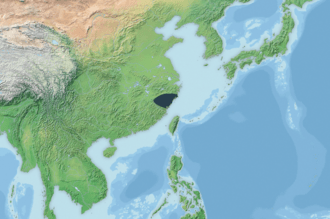
Chinese Alligator

Other names include the Yangtze Alligator, Chinese alligator or historically the Muddy dragon. It grows to between 1.5m and 2.1m, and weighs 36-45kg. In winter in Brumates (a form of hibernation) and is generally nocturnal in summer. It is restricted to 6 regions of the province Anhui, with possible small populations in possibly the provinces of Jiangsu and Zhejiang.
Originally having a far larger range, which stretched as far as Japan, but starting in 5000BC various threats started to reduce their range and numbers – the biggest being habitat destruction. In 1970 only around 1000 remained, and fell to 130 in 2001. However, after 2003 the population started growing again and is currently estimated at around 300. Despite this improvement, it is still listed as critically endangered, and much work is still underway to protect its future. There is strong evidence to suggest that the Chinese alligator is the source of the Chinese dragon idea.
The earliest fossil, which looks like the current animal, was found in Japan and dates from around 3 million years ago.
The Chinese alligator once ranged across most of China. However, today this species is largely restricted to a 433 square kilometre reserve in the Anhui province of the lower Yangtze. At this point, the alligator’s geographic range has been reduced by 90%.
In 1998 it reached its smallest population size with a total population not greater than 150. As of 2018 it was not considered declining, though if it is to recover it must find space in one of the most populous countries. China lists it as class one endangered, while CITES has listed it as appendix one, and the IUCN lists it as critically endangered since 2017. In 1982 the Anhui National Nature Reserve for Chinese Alligator was created, which spanned all its remaining territory. This reserve covers 75 square miles (180 square km).
As of 2016 there are 20,000 in captivity, meaning that while their wild population is pretty precarious, there should be many for reintroduction if something should wipe them out in the wild.
There have been several attempts to create second wild populations for these Alligators with limited success, but these may grow into sensible backups over time.










